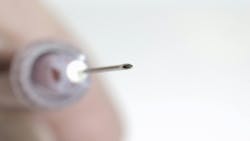Ouch! What to do in case of a needlestick
It happened so fast! Not only was I in pain from the needlestick, but I was worried about catching something.
I remember that I was doing what dental assistants do best—multitasking. I had to get my room turned over, have a conversation with a teammate about where to find a lab case, and dismiss my patient, all at the same time. My attention was not focused on any one of these important tasks, when suddenly all my attention was on my throbbing and bleeding finger!
I know I’m not the only one who this has happened to, and just like you, my reaction was fear and confusion all at the same time. What happens first? Do I need to notify someone? Do I need a test to determine if I have super-duper cooties?
The good news is that the Bloodborne Pathogens Standard provides clear guidance on what to do in the event of an accidental exposure. We’re told to follow these important steps immediately:
1. Evaluate the wound to determine the severity. Does it need medical attention?
2. If it’s determined that you need medical attention, go!
- Take a copy of the Bloodborne Pathogens Standard with you in case the physician does not have one.
- Your office’s Exposure Control Plan should include information about the physician or urgent care you should visit. You can also make an appointment with your own physician. You will need to take workers’ compensation insurance information with you if prior arrangements have not been made.
- There should be contact information for the physician or urgent care located next to the phones in the office. This is also required as part of the Bloodborne Pathogens Standard.
3. Work with your office’s OSHA coordinator to file an incident report that provides details of the injury.
- OSHA form 301A asks for details about the incident such as date, time, how the injury occurred, what or if treatment was given, and any follow-up plans.
- Additionally, a sharps injury log OSHA 300 logs the same details minus employee name and personal information. This should be placed in the office’s OSHA binder.
- A copy of the incident report should be placed in your confidential employee medical record and kept for 30 years past employment.
4. If possible, identify the source patient unless your employer can establish that identification is infeasible or prohibited by state or local law. Information for source patient identification can be found in most state dental practice acts.
- If allowed by state law, the source individual's blood should be tested as soon as feasible and after consent is obtained in order to determine HBV and HIV infectivity.
- If consent is not obtained, the employer should establish that legally required consent cannot be obtained.
- When the source individual's consent is not required by law, the source individual's blood, if available, should be tested and the results documented.
- If the source patient declares their medical status as HIV or HBV, then that patient does not need to be tested.
- Making sure to follow all HIPAA guidelines concerning patient privacy, you have the right to know the source patient’s test results in order to take appropriate action.
- You have the right to have a blood collection but can hold off on HIV/HBV testing for up to 90 days.
- Finally, you are afforded the opportunity to seek follow-up medical care and counseling.
Know and use work practice controls for needle recapping with the scoop method or recapping devices. As part of sharps injury protection, OSHA requires evaluation of technology for safer recapping, or needle removal systems to be conducted annually as part of the offices Exposure Control Plan updates. See the Bloodborne Pathogens Standard for more details.
Working smarter and safer is the best way to prevent injury for yourself and your teammates. Educating yourself with the steps you need to take in the event of accidental exposure helps take some of the immediate fear and confusion out of an unfortunate incident.
For additional information about sharps injury prevention, visit OSHA’s Bloodborne Pathogens and Needlestick Prevention page. For questions or comments please feel free to reach out to me at [email protected].
Be safe out there everyone!
Sherrie Busby, EDDA, CDSO, is the dental assistant and OSHA/infection control training developer for Heartland Dental in Effington, Illinois. You can contact her at [email protected].
About the Author
Sherrie Busby, EDDA, CDSO
Sherrie Busby, EDDA, CDSO, is a dental assistant training developer and OSHA coordinator for Heartland Dental in Effington, Illinois. She provides information and training on dental software, documentation guidelines, and clinical techniques.
